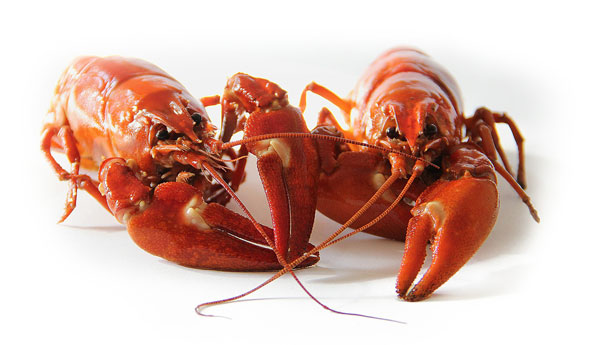
If your homestead is located anywhere near water, particularly the flowing variety, chances are you’ve wet a line or two, and made yourself better acquainted with several varieties of aquatic wildlife. In doing so, you may have stumbled across some strange critters lurking along the bottom, particularly under rocks–critters that look a heckuva lot like a miniaturized variety of your last meal at Red Lobster. These freshwater lobster lookalikes, also known as mudbugs, crawdads and crayfish, are actually quite tasty, and have long been considered something of a delicacy in the South. Read on for some creative ways to catch yourself a parcel of the critters, perfect for inclusion in a low-country broil.
Line and Pole
Turns out, if you have a fishing pole, some quick reflexes and some patience, you can catch crawdads on a pole pretty easily. Simply find a location with clear-flowing water and large flat rocks. Bait your hook with a small bit of worm, like you would for a fish, and dangle it around the edge of the rocks. Work it with a little bit of motion, like you would a jerk bait (without the reeling-in part), and wait for the bugger to strike. Once he locks on with his claw, reel it on in quick, and boom! You’ve got yourself a crawdad.
Bottle Trap
Now while the above method is quite a fun way to while away some hot summer hours, it’s pretty time consuming. In fact, if your objective is a full meal, chances are you may burn more calories catching the damn things than you’d consume. For that reason, when going for bulk, it’s best to build a trap.
The easiest sort of trap to make can easily be constructed out of a bottle. Though any will work, a 3 liter or gatorade bottle suit best. Start by cutting the top of the bottle off, at a point below the curve. In other words, make sure your cut runs along the widest diameter of the bottle. This is generally about a third the way down. Take the cap off, and spin the freshly cut top around, inserting it into the bottle’s now open mouth. Secure it here with glue, staples, zip ties, or anything else you can reliably use to keep the top securely pressed against the bottom’s walls. Take some rocks, and put them through the top. These will serve as weights to sink the bottle to the river’s bottom. Next, punch a hole in the lip of the bottle, just behind where the top and bottom are joined, and tie a string to it. Once you get to the river, you’ll tie this string to a nearby tree branch or other anchor, both to secure it in one spot, and so you’ll be able to retrieve it. Finally, put a couple slices of meat in the bottle. Hot dogs work, as does pretty much any form of meat–fish heads, gristle, chum bait, etc. This, obviously, will serve as your bait.
Take your contraption, toss it in and tie it off. Leave it for at least an hour, though for best results I generally wait several–never longer than a day. The crawfish, smelling the bait, will crawl through the bottle top to eat. Once inside, they will drop to the bottom, and be unable to find their way back out. Set a few traps in as many areas, and you’ll soon have an aquatic feast ready and waiting for your collection!
A humble homesteader based in an undisclosed location, Lars Drecker splits his time between tending his little slice of self-sustaining heaven, and bothering his neighbors to do his work for him. This is mainly the fault of a debilitating predilection for fishing, hunting, camping and all other things outdoors. When not engaged in any of the above activities, you can normally find him broken down on the side of the road, in some piece of junk he just “fixed-up.”

ChiptheBarber says
You don’t suck out the innards, you suck the “sweet meat” from the head. Hence the well known saying (and song) Suck the Heads, Squeeze the Tips. Everything you need to know about eating crawfish is contained in the song. If you need more visual instruction there are any number of Youtube videos out there. A former neighbor of mine was as Cajun as anybody could be. We were at a local seafood buffet 30 years ago and she was there. I took 5 crawfish to her on a saucer and asked her to show me how to eat them. She downed all 5 within 30 seconds with a one-handed technique that was a marvel to behold. It took about a gross of crawfish before I had the method perfected. Where ever you are, Lolita I would like to thank you for a very important life-skill.
William Moody says
You’re correct. I stated “suck out the innards” because that was what my coworkers told me when teaching me how to eat them, and, squeezing the tail like a tube of toothpaste is also correct, just forgot the technique as its been a while since I’ve had the opportunity to enjoy a good, hefty bunch of them.
Tom says
Having grown up in Louisiana I’ve eaten my share of crawfish. The best way to cook them is to add them to a pot of boiling water with shrimp boil. Return to a boil and take out after 12 minutes. If possible put them on ice. Or put them in boiling water and when the water returns to a boil remove from heat, cover and let sit for 15 minutes. To eat them grab them where the tail joins the body, pull and twist. Remove the first 2 rings at the top of the tail, pull on the meat while squeezing the bottom of the tail with your other thumb, like squeezing the bottom of a toothpaste tube.
Susan Wojtkiewicz says
There are several washes in Las Vegas that run down to Lake Meade. We used to go out with a 5 gallon paint can and a set of tongs at night and catch dozens of them with just a flashlight to help see them. Pick them up with the tongs and drop in the bucket. Good eats!
Arch says
Before you cook them, put them in a container with salt added to the water. Wait few minutes and the salt water will purge the crawdad’s digestive tract and the water will look muddy. rinse them off and throw them into the cooking pot. You won’t have to seperate the “mud vein” while you eat them.
Will says
This has been proven false by LSU. It is an old wives tail. A google search should show that salt has no effect.
William Douglas Moody says
When working around New Orleans I learned from the Cajuns I worked with how to prepare and eat “mudbugs.” After boiling them in their special seasoning, you break them in two at the carapace and suck the innards from the front half and peel the shell from the tail, exposing a small but delicious mini lobster tail. One of the South’s greatest delicacies.
Ray says
In shallow, clear streams, it is often possible to catch crayfish by hand if quick enough. Turn over rocks or debris until they are found and then quickly grab them by the carapace near the junction of the claws (chelae). This puts your fingers behind the claws whereby they are unable to pinch. Another effective method to capture crayfish is by lift net. A small mesh net, approximately 2-feet square, secured at each corner with string that is tied together above the net with a long enough lead to reach the stream edge (or better yet, a pole extended above the water) can be set with some type of meat as an attractant. The meat should be securely tied in the center of the net and the net laid out on the bottom (weighted if necessary) of a shallow stream or lake edge. Left to “fish” for a period of time (dusk, dawn, or night often most effective), the net then can be lifted quickly, entrapping any crayfish that are feeding on the bait. Multiple nets may be needed for best results. Note: a wire or wood (tree branch) arching x-shaped frame fastened to each corner of the net in lieu of the string helps to keep the net spread on the bottom while “fishing”.
Walter A Hutcherson says
Go on and describe how you cook and then peel to eat them. A lot of people have heard of them and now know how to catch them but never having caught them need to know how to cook them. And then exactly how to peel and them to eat them.